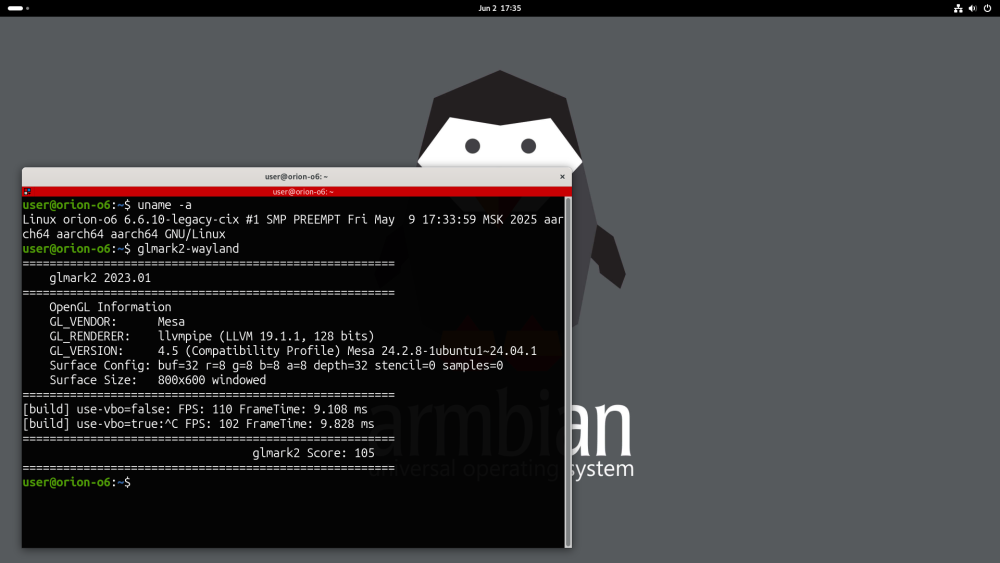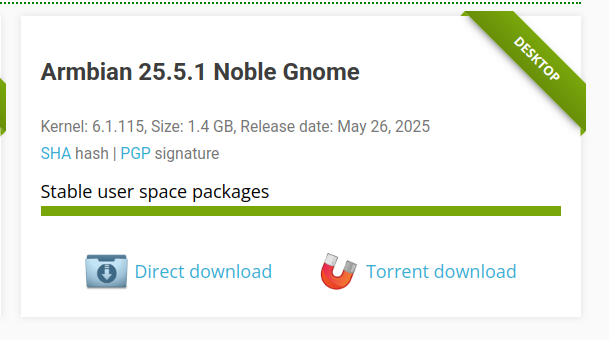Active threads
Showing topics posted in for the last 365 days.
- Past hour
-

Helios-64 Fails to boot since upgrading to Bookworm
Carlos Hartmann replied to Carlos Hartmann's topic in Rockchip
Briefly tried with Bullseye and the fans don't even come on. Could be the "refusing to boot without drives" behavior mentioned before. Will try both Bullseye and Buster on my original machine on Sunday and see if anything changes. -
I tried loading the current image (Debian 12 (Bookworm)) on another SD card from https://www.armbian.com/orange-pi-lite/ and it doesn't boot at all (green light doesn't come on). Could this have something to do with my issue?
-
The same issue with Kernel 6.12.23, my flashdrive can not be found. Kernel 6.6.75 is still doing its work
-
Maybe not for the ROCK 5 ITX, but for my ROCK 5 B (no eMMC) I can get EDK2-UEFI (v1.1) loaded from SPI or SD. The problem is with all those many Rockchips boards is that they have varying or unknown strategy or setting what the priority of boot devices is. AFAIK seen in some schematics, SARADC and some resistor tree is used. Then it also depends if the U-Boot or EDK2-UEFI or else is hopping to other (MaskROM) readable device or not. I saw it all can be configured in U-Boot (seen on denx.de) but it seems to me that it is almost impossible to make a generic solution. The various wikis seem to describe what is needed to get things working, but my v1.46 ROCK 5 B does not have a header/jumper where I can disable SPI. I see that on Radxa wiki, but older board version I guess. My ROCK 3 A has that header/jumper, so that I used to force only SD-card. For my ROCK 5 B zeroing or erasing SPI is the solution. If I keep Armbian U-Boot edge in SPI, the UEFI on SD-card is ignored. Another thing I also might have had earlier is that the secondary/backup GPT at the and of the device could have still be there, so that is or can be a conflicting situation, for a bootloader, I don't know what is checked in U-Boot etc for example. But if no plans with rest of SD-card I mostly do the use 'sudo blkdiscard' then on the whole SD-card, so all wiped and trimmed.
-

Armbian rolling Testing/Trixie does not upgrade Armbian packages
eselarm replied to eselarm's topic in Radxa Rock 5B
Armbian packages get updated now, so now upgrading to 25.8.0-trunk.100, from .87 I did earlier yesterday. Also now running 6.15.0-edge-rockchip64 with EDK2-UEFI v1.1 in SPI. Need setting to DeviceTree as the default (Both = ACPI and DeviceTree) seems to confuse 6.15.0-edge-rockchip64, got only serial console only or stall somewhere in boot process. - Today
-

Is it possible to boot Armbian from SD card only?
temporary_name replied to temporary_name's topic in Amlogic CPU Boxes
Jens J, woah, I didn't know that you can just split bootloader like that! I did that, and so far, it looks good! TV Box boots into u-boot with this SD card, and it has a partition table. Thank you so much! Now I'll try to make an SD card with system on it -

Armbian on Box K12 Bqeel / Mini M8S pro C (S912)
Jens J. replied to RuDy_74's topic in Amlogic CPU Boxes
Have you tried `/boot/dtb/amlogic/meson-gxm-mini-m8s-pro.dtb` ? What is wifi chip? Is it LTM8830? If so this is QCA9377 clone, and this dtb should be fully working. -
Any luck yet? I have a v4.1 board. None of the image is working. Anyone tried these ? https://github.com/velvet-os/imagebuilder/blob/main/systems/allwinner_h616/readme.md
- Yesterday
-
Hi everyone, I’m working on a custom Armbian build for an RK3588-based board (cm3588-nas) and trying to completely disable the Rockchip crypto driver (rk_crypto2), since it's negatively impacting LUKS (AES-XTS) performance. Despite several attempts, the module continues to register algorithms in /proc/crypto after boot: driver : rk2-sm3 module : rk_crypto2 driver : rk2-sha512 module : rk_crypto2 driver : xts-aes-rk2 module : rk_crypto2 ... ------------------------------------------------------------ What I’ve Tried ------------------------------------------------------------ 1. Kernel Config Override - Added CONFIG_CRYPTO_DEV_ROCKCHIP=n and CONFIG_CRYPTO_DEV_ROCKCHIP2=n to: userpatches/linux-rockchip-rk3588-edge.config - Verified .config has it set to n after build. - Used CLEAN_LEVEL="make,debs,oldcache" in the build command. 2. Blacklisting & Deletion in customize-image.sh echo "blacklist rk_crypto" > /etc/modprobe.d/blacklist-rk_crypto.conf rm -f /lib/modules/*/kernel/drivers/crypto/rockchip/rk_crypto.ko* 3. Post-Boot Verification - lsmod | grep rk_crypto → empty - modinfo rk_crypto → module not found - /proc/crypto still shows rk2-* drivers tied to rk_crypto2 4. Manual Source Removal - Commented out this line in drivers/crypto/rockchip/Makefile: # obj-$(CONFIG_CRYPTO_DEV_ROCKCHIP) += rk_crypto.o - Also removed or disabled its Kconfig entry. ------------------------------------------------------------ System Details ------------------------------------------------------------ Board : cm3588-nas (RK3588) Kernel : rockchip-rk3588 edge (Linux 6.8.x) Builder : Official Armbian compile.sh ------------------------------------------------------------ Goal ------------------------------------------------------------ I want to fully disable the Rockchip crypto engine (rk_crypto2): - It should not load, not build, and not register anything in /proc/crypto. - LUKS should fall back to software crypto (cryptd, aesni, or default fallback). ------------------------------------------------------------ Any help is appreciated. I’d love to hear from anyone who’s successfully disabled rk_crypto2 entirely or has ideas for where the registration is coming from even when the module appears removed. Thanks!
-
Hi @Vodalex, Write down the MAC address of the interface you want to use to wake up the Helios4. ip link show You would need to put the Helios4 in suspend, by either: sudo pm-suspend or: echo 'suspend' | sudo tee /sys/power/state To wake it up, from another system, make sure that wakeonlan is installed. Then: wakeonlan ${HARDWARE_ADDRESS} That should be it. Groetjes,
-
Did anyone managed to get Linux working on TX6S?
-

what can you tell about the non free software bl30 blob?
Igor replied to renky's topic in Libre Le Potato
This is what AI tells: Role of BL30 The BL30 component serves as the firmware for the Amlogic Secure Co-Processor (SCP). Its primary responsibilities include managing system-level operations such as Dynamic Voltage and Frequency Scaling (DVFS) and handling suspend/resume functionalities. These tasks are crucial for optimizing power consumption and ensuring efficient thermal management within the system. lists.denx.de In addition to BL30, there is a closely related component called BL301. BL301 acts as a board-specific firmware "plug-in" that provides customized parameters for DVFS and suspend/resume operations, tailored to the specific hardware configuration of the board. lists.denx.de Integration into the Boot Process The typical boot sequence in Amlogic devices follows this order: BL2 → BL30 → BL31 → BL33. Each stage is responsible for initializing specific aspects of the system, with BL30 focusing on power management and system control tasks. If any stage fails, the boot process may attempt to fall back to an alternative boot medium, although this behavior can vary depending on the specific SoC and its configuration. 7Ji’s Blog+1lists.denx.de+1 Understanding the role of BL30 is essential for developers and system integrators working with Amlogic platforms, especially when customizing firmware or troubleshooting boot-related issues. All Amlogic SoCs boards needs this. AFAIK here we don't have open source alternative. Only from the owner of this file after you sign certain papers https://www.amlogic.com/#Company/Contact/index.html This is complex operation and possible where / when there is a big enough interest and when more people join in this common interest and are willing to sacrifice months of their precious private time. https://github.com/crust-firmware/crust Here is an example of similar feature for some other SoC (allwinner). It works, but it's also not feature complete and probably never will. Many of those SoCs are already commercially obsolete, similar for the one you are asking. -
-
Thanks! Just run upgrade to 6.12.30 - and sounds works! (on 6.12.20 was no sound card in aplay -l )
-
@MBeck @batoisai I’m selling mine as well (Belgium) if one of you guys are still interested. Work as intended, maintained well (looks as new), no 2.5Gbit LAN mod done either.
-

Install non-vendor image (kernel 6.12+)
Jurgen.Schober replied to Jurgen.Schober's topic in Radxa Rock 5 ITX
Replying to my own post. ... EDK2 has an UEFI BIOS which runs mainline linux - no custom builds. It supports ACPI and device tree. I run this now with Fedora Rawhide 43 with KDE (6.4 Beta) which runs ACPI out of the box, older kernels work with device tree. I haven't used the latest mainline Armbian but that should work, too (at least the latest mainline image). Rawhide runs mainline kernel 6.15/6.16 (latest build) which supports the SOC + GPU out of the box. -
Testing the M2 16G with trunk 90 (Kernel 61.15) & trunk 38 (Kern 6.14.8) and the USB-C OTG port isn't working. [ +0.245948] usb 7-1: new full-speed USB device number 2 using xhci-hcd [ +0.124258] usb 7-1: device descriptor read/64, error -71 [ +0.227984] usb 7-1: device descriptor read/64, error -71 [ +0.223715] usb 7-1: new full-speed USB device number 3 using xhci-hcd [ +0.124295] usb 7-1: device descriptor read/64, error -71 [ +0.223803] usb 7-1: device descriptor read/64, error -71 [ +0.104107] usb usb7-port1: attempt power cycle [ +0.395844] usb 7-1: new full-speed USB device number 4 using xhci-hcd [ +0.000112] usb 7-1: Device not responding to setup address. [ +0.203891] usb 7-1: Device not responding to setup address. [ +0.203946] usb 7-1: device not accepting address 4, error -71 [ +0.000609] usb 7-1: WARN: invalid context state for evaluate context command. [ +0.119353] usb 7-1: new full-speed USB device number 5 using xhci-hcd [ +0.000118] usb 7-1: Device not responding to setup address. [ +0.204373] usb 7-1: Device not responding to setup address. [ +0.207473] usb 7-1: device not accepting address 5, error -71 [ +0.000613] usb 7-1: WARN: invalid context state for evaluate context command. [ +0.000109] usb usb7-port1: unable to enumerate USB device [ +30.217458] usb 7-1: new full-speed USB device number 6 using xhci-hcd [ +0.123993] usb 7-1: device descriptor read/64, error -71 [ +0.231951] usb 7-1: device descriptor read/64, error -71 [ +0.223935] usb 7-1: new full-speed USB device number 7 using xhci-hcd [ +0.120028] usb 7-1: device descriptor read/64, error -71 [ +0.224108] usb 7-1: device descriptor read/64, error -71 [ +0.103939] usb usb7-port1: attempt power cycle [ +0.396008] usb 7-1: new full-speed USB device number 8 using xhci-hcd [ +0.000139] usb 7-1: Device not responding to setup address. [ +0.203807] usb 7-1: Device not responding to setup address. [ +0.207853] usb 7-1: device not accepting address 8, error -71 [ +0.000608] usb 7-1: WARN: invalid context state for evaluate context command. [ +0.119394] usb 7-1: new full-speed USB device number 9 using xhci-hcd [ +0.000140] usb 7-1: Device not responding to setup address. [ +0.204031] usb 7-1: Device not responding to setup address. [ +0.203926] usb 7-1: device not accepting address 9, error -71 [ +0.000796] usb 7-1: WARN: invalid context state for evaluate context command. [ +0.000293] usb usb7-port1: unable to enumerate USB device [Jun 2 19:50] usb 7-1: new full-speed USB device number 10 using xhci-hcd [ +0.123926] usb 7-1: device descriptor read/64, error -71 [ +0.116517] xhci-hcd xhci-hcd.7.auto: remove, state 4 [ +0.000011] usb usb8: USB disconnect, device number 1 [ +0.000280] xhci-hcd xhci-hcd.7.auto: USB bus 8 deregistered [ +0.000009] xhci-hcd xhci-hcd.7.auto: remove, state 1 [ +0.000004] usb usb7: USB disconnect, device number 1 [ +0.055430] usb usb7-port1: attempt power cycle Same USB-C device (CCD camera) tested and working in the USB-3 port.
-
First of all, I would like to thank the developers for making this possible. I have two MXQs, one with OMV and the other running raspotify with a DAC. Thank you very much, it was a great addition to my homelab. I noticed that docker container support for armhf has been discontinued over time. Does anyone have a list of docker images for armhf?
-

Regression in CB1 kernels for network drivers general instability
ressu replied to ressu's topic in BIGTREETECH CB1
The 25.5.1 kernels seem to have landed in the APT repos. I can confirm that at least the `current` kernel now has networking working as intended. I haven't checked the legacy kernel whether it works enough for a semi reasonable upgrade path. But I'll see that once I get to upgrade the other CB1 boards I have. -
I haven't tested these functions, I don't know if it works or not. https://docs.armbian.com/User-Guide_Getting-Started/#first-login
-

NVME boot issue with 25.5.1 Noble Gnome and a work around
vinrich replied to vinrich's topic in Orange Pi 5
-
https://docs.armbian.com/User-Guide_Board-Support-Rules/ support a whole soc family would be impossible. For example a vendor could do a poor implementation of something which could never work but we "support" it and people complain why it doesn't but there would be literally nothing we could do about.
-
https://askubuntu.com/questions/1371732/what-is-the-purpose-of-cgroup-enable-cpuset-cgroup-enable-memory-cgroup-memory-1 Without further research the answer here mentions that the flags in question may be specific for RaspberryPi, hence won't work on other kernels/boards.
-
All images are specifically made for the board. Some share the same kernel package since they are from the same soc family (for example, there are a lot of boards using the rk3588/s soc so they can have the same kernel package. Board's components are defined in device tree). Sample board config: https://github.com/armbian/build/blob/main/config/boards/orangepi5pro.csc BOARD_FAMILY is rockchip-r3588 The sources config: https://github.com/armbian/build/blob/main/config/sources/families/rockchip-rk3588.conf Pro, max and ultra are community contributions and for now entirely unsupported since there is also no support from the vendor for us for these whatsoever to make its software better.







